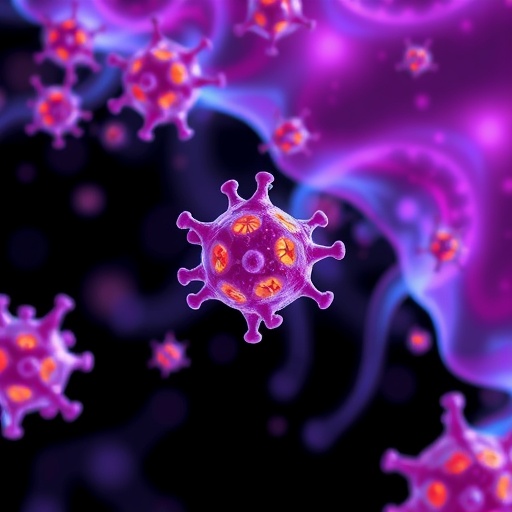In a groundbreaking advancement for cancer immunotherapy, researchers from the School of Medicine at Zhejiang University have elucidated a novel mechanism by which colorectal cancer stem cells (CSCs) evade immune system attack. Published in the prestigious journal Science Bulletin, this study, led by Professor Jimin Shao, reveals how inflammatory signals, specifically the cytokine interleukin-6 (IL-6), drive heterogeneous intracellular signaling that enables CSCs to express immunosuppressive PD-L1 and circumvent immune-mediated clearance. These findings address a crucial obstacle in current immunotherapeutic resistance and offer innovative avenues for tailored combination treatments.
The research centers on the pivotal role of IL-6, a cytokine long recognized for its involvement in promoting PD-L1 expression in various cancers. While the induction of PD-L1 by IL-6 in non-cancer stem cells (non-CSCs) follows the canonical JAK-STAT3 pathway, this study uncovers a strikingly divergent signaling route operating in CSCs. In differentiated cancer cells, IL-6 engagement leads to phosphorylation at the Y705 residue and acetylation at K685 of STAT3, facilitating the formation of a transcriptionally active STAT3-FRA1 complex that directly binds promoter regions of CD274, the gene encoding PD-L1. This classical cascade promotes PD-L1 transcription and contributes to immune checkpoint activation.
Contrastingly, colorectal CSCs undergo a radical signaling switch, wherein IL-6 triggers PI3K-AKT-ZEB1 axis activation instead of STAT3 phosphorylation. This signaling rerouting bypasses the standard JAK-STAT3 transcriptional machinery, actively recruiting the epithelial-mesenchymal transition (EMT) transcription factor ZEB1 to the CD274 promoter. Notably, ZEB1’s DNA binding site overlaps with that of FRA1, suggesting competitive binding dynamics that favor immune evasion pathways specific to CSCs. The application of LY294002, a selective PI3K inhibitor, effectively abrogates PD-L1 induction exclusively in CSCs, underscoring the mechanistic specificity of this alternative pathway.
Delving into the molecular underpinnings of this signaling divergence, the team identified the enhanced activity of SHP2 phosphatase within CSCs as a key factor. SHP2 attenuates IL-6-mediated JAK-STAT3 signaling, thereby facilitating a redirection towards the PI3K-AKT cascade. This phosphatase-mediated rheostat function effectively transforms IL-6 signaling outcomes and reinforces the CSC’s capacity for immune escape through elevated PD-L1 expression. The competitive binding of ZEB1 versus the STAT3-FRA1 complex on the CD274 promoter further consolidates the dominance of this CSC-specific immunosuppressive program.
In a translational leap, the researchers validated these mechanistic insights within a cohort of 70 colorectal cancer patient samples. Tumors characterized by elevated IL-6 levels demonstrated a higher prevalence of PD-L1-positive, ZEB1-expressing CSCs accompanied by a notable depletion of cytotoxic T lymphocytes, indicating an immunosuppressive tumor microenvironment shaped by the novel signaling axis. These patient-derived data reinforce the clinical relevance of the discovered pathways and hint at biomarkers indicative of immune evasion and therapeutic resistance.
The therapeutic implications of these discoveries were probed in murine models genetically humanized for IL-6 expression. Strikingly, monotherapies targeting either the PI3K or STAT3 pathways, or immune checkpoint blockade alone, produced limited tumor regression. However, a triple combination regimen encompassing a PI3K inhibitor, a STAT3 inhibitor, and anti-PD-L1 antibodies induced profound tumor shrinkage. This combinatorial strategy simultaneously obstructs diverse escape routes exploited by CSCs and non-CSCs while rejuvenating T-cell-mediated anti-tumor immunity, exemplifying a precision medicine paradigm.
Professor Jimin Shao, the study’s corresponding author, emphasizes the potency of this integrated approach: “By simultaneously dismantling both IL-6-driven immunosuppressive signaling pathways, we effectively erode the protective barrier cancer stem cells construct against immune attack.” He further suggests the implementation of tumor or blood-based diagnostics measuring IL-6 and PD-L1 levels as predictive tools to stratify patients likely to benefit from such targeted combination therapies, a step toward personalized oncology.
The complexity of immune evasion in colorectal cancer is hence unveiled as a dynamic interplay of cellular heterogeneity and context-dependent signaling rewiring. This study highlights the transformative effect of post-translational modifications — phosphorylation and acetylation of STAT3 — in dictating transcriptional partnerships and gene expression programs in differentiated cancer cells, while uncovering how protein activity modulation via SHP2 shapes alternative transcription factor engagement in CSCs. Such mechanistic depth extends our molecular understanding of tumor immunobiology.
Moreover, the identification of ZEB1 as a pivotal transcriptional regulator of CD274 in CSCs broadens the functional repertoire of EMT-associated factors beyond their canonical roles in metastasis and invasion. The bridging of oncogenic signaling with immune checkpoint regulation underscores an intricate nexus between tumor plasticity and immune suppression, reframing EMT not only as a driver of phenotypic cellular transitions but also as a modulator of tumor immune landscapes.
The research team at Zhejiang University continues to validate these biomarkers and signaling pathways in extensive clinical cohorts, aiming to translate laboratory insights into effective therapeutic regimens. Their findings present a compelling case for combination immunotherapies tailored to cellular context and signaling heterogeneity within tumors, potentially reshaping clinical management strategies for colorectal cancer patients resistant to conventional single-modality treatments.
This study exemplifies the critical need to dissect cellular and molecular diversity within tumors to unravel mechanisms underpinning immunotherapy resistance. As the field progresses, such integrative approaches that map distinct signaling networks in subpopulations of cancer cells will pave the way for refining immune checkpoint blockade and overcoming tumor immune escape, ultimately improving patient outcomes.
By delineating an IL-6-induced STAT3-to-PI3K signaling switch that drives ZEB1-dependent PD-L1 expression, this work not only fills a vital knowledge gap but also provides a beacon for designing next-generation combination therapies that simultaneously target the multifaceted immune evasion tactics of colorectal cancer. Its implications reverberate through both fundamental cancer biology and clinical translational science, heralding a new chapter in combating one of the deadliest malignancies worldwide.
Subject of Research: Immuno-oncology, colorectal cancer stem cells, IL-6 signaling, immune evasion mechanisms, PD-L1 regulation.
Article Title: How IL-6 Signaling Rewires Immune Checkpoint Control in Colorectal Cancer Stem Cells
Web References: http://dx.doi.org/10.1016/j.scib.2025.07.013
Image Credits: ©Science China Press
Keywords: Colorectal cancer, cancer stem cells, IL-6, PD-L1, immune evasion, JAK-STAT3 pathway, PI3K-AKT pathway, ZEB1, tumor microenvironment, immunotherapy resistance, SHP2 phosphatase, EMT transcription factors




